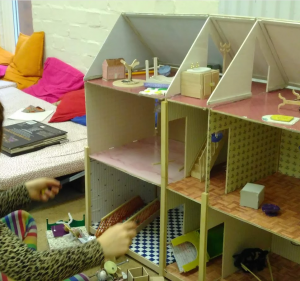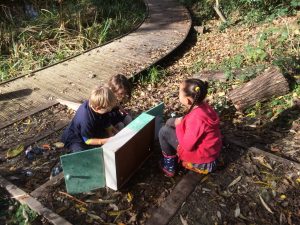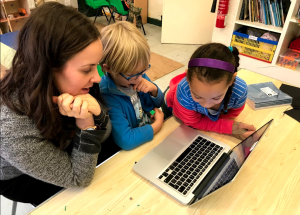By Rowan Salim
 We need space, place and time to do the things we need and want to do. The conditions which we create to enable the creative or learning process have a direct impact on the process and the outcome.
We need space, place and time to do the things we need and want to do. The conditions which we create to enable the creative or learning process have a direct impact on the process and the outcome.
I’ve been thinking for a while about the spaces, places and times the children have at their hand while in the ‘Home Space‘ at Dacres Wood to do the things they need to do, whether that’s building a den, making crafts, exploring the anatomy of birds, reading, writing, being cats, or making trade.
Activities and interests emerge from their daily interactions with each other, with their families, with visitors, with places they frequent and of course with the forest and the resources we have. Their abilities to pursue those interests are determined by the nature of the spaces, places and times in which they can do so.
I’ve been thinking about this for some time as a theme I would like to explore in my blog. I found myself thinking about it in snippets between this and that, on my bike, cycling in to Dacres Wood, or waiting in the queue at self check-out in the supermarket. But it took me a while to sit down and write. Without considering it beforehand, I found that in order to create the space, place and time to write, I had to intentionally get rid of distractions. I put my phone away, on silent, so that the buzzer doesn’t attract my attention. I had my dinner beforehand so that I don’t feel rushed to eat or have food on my mind. I set my computer up in my most comfortable spot, I got myself a glass of water in case I got thirsty, and I ticked off as many items as possible on my to-do list beforehand to make sure that any anxieties around other things I have to do are brushed away.

So in order to write, and do the thing I wanted to do, I had to put aside time, create space, and make place with the necessary order, so that I could gather my thoughts, understand them, put them together into a narrative which makes sense to me and to the readers.
If I intentionally wanted to do other things, like learn a language, design my garden, or even play volleyball, I would likewise consider the conditions which I would need in order to do those things. I could try to play volleyball in my bedroom, or with a football, or with a team of 3, but it’s likely not going to be as good an experience as having just the right conditions.
So what about the spaces, places and times which children have to do the things they need to and want to do at Dacres Wood?
There are plenty of spaces at Dacres Wood. There are two spacious indoor rooms. There is a bathroom, a kitchen and a hallway. Outside there is a courtyard, a garage and a quiet little alcove behind the garage. In the reserve, there is the boardwalk, the pathways, the dipping platform, the snake bench, the meadow, the circle, the museum, the echo tree and the cauldron tree, and myriad other nooks and crannies.
What about the places? Each of these spaces have materials, histories, stories, and even rules, which determine the way that children will interact with the space. The quiet room for example is full of resources which determine what might happen there. Rules about noise level, and the nature of entry and exit are intended to safeguard the ability to engage in activities and pursuits in that room which children may not be able to engage in elsewhere.
The space behind the garage has a collection of scavenged wood, furniture and neighborhood flotsam and jetsam which has been gathered for building and making. The space has a history of house building dreams, which a sturdy brick wall reminds us of. As a space reserved for small meetings, it also has a seriousness about it, focus, conversation and purpose. And the wall separating it from the neighbours garden is a constant reminder of expectations regarding how activities in the space might affect their own peace.
Each space at Dacres Wood hence becomes a place which may or may not be amenable to certain activities. This is compounded by social relations. For example, the meadow is an inviting open space for play and creation. The openness of it however also makes it inviting for others to join in. Create in the meadow, and there are 5 paths from which others can pass by to see what you’re doing, offer opinions, ask to join in. So everyone knows, that if you need privacy and quiet, the meadow is not the place to do it! Of course if you’re looking for collaboration and engagement, then by all means!
This very topic was brought up by two of the children in one of the meetings. They had found that it was difficult to play without others wanting to join them. They worried that requesting privacy would feel like rejection and would cause upset. This conundrum left them frustrated as they were unable to do some of the things they wanted and needed to do. It would be like my doorbell ringing with visitors each time I sat down to write this blog post. I imagine that being a parent may be a little like that!
And then there’s the element of time. The children’s time at Dacres Wood is compartmentalized with a slot before the meeting, another before lunch, another after lunch, and a mini slot between tidy up time and story time. This last slot was intentionally carved out by the children who expressed a desire for a final nugget of time to play or complete projects before the day was over.
So this function of space, place, time and social relations determines whether and how the children at Dacres Wood can pursue their interests. The ability to immerse oneself in one’s interest (as I am doing now in writing this blog post) can be described as being in a state of flow. Over the last year, in observing the children and noting the evolution of their interests, I have realized that one of the fundamental elements of my job is as a guardian of flow. Facilitating the creation of the optimum conditions within this matrix of spaces, places, times and social relations, to allow children to pursue their interests. There are many times over the past few months where I have observed that this balance has been fragile or has even tumbled. When this happens, chaos and frustration happens, or activities take place, but not to their optimum potential.

There are many more times still where the balance has been struck beautifully. Such as Friday afternoon when Sally, Aurelien and Frankie spent two hours, undisturbed, editing the Crown Thief video; or Thursday afternoon when the children doing the first aid course requested an extra slot for the course to make up for the missed session due to the ice skating trip, or Wednesday when walking past the music room, I could hear 6 children harmonizing while singing a new song Carlotta (our intern) had just taught them. We observe it most often during uninterrupted free play.
Moving into the second year at Dacres Wood, where most of the children know each other fairly well, and their different interests are becoming more apparent, the need to be conscientious guardians of flow is becoming clearer. The first year was characterized by a vibrant need to socialize and get to know each other and the place. The nature of play reflected the children’s desire to mark out and map each other’s characters. A free and loose structure of places facilitated this, and last year I would say that the children were able to spend much of their time doing so intentionally and deeply.
This year, I can see that the children’s interests are being diverted elsewhere, and as we move into this new phase of life at Dacres Wood, it will be important to safeguard the places and times needed to explore these new interests.
This of course poses a challenge when welcoming new children to the community. New children often arrive burning to socialize, to get to know other children, play with them, suss them out, figure out who they are in the space. This burning need doesn’t always align perfectly with the needs of the other children to get on with other interests, and can create challenges in safeguarding the conditions to meet each of their needs. The emergent awareness of this dynamic among the facilitators is helping to prepare better for the smooth integration of new children into the community.
As for me, I’m done writing. I feel content with the piece and am grateful for my insights and self awareness to know what conditions I need in place to write. I can now pack up, go to bed, and be ready for my new list of things to do in the morning.
Rowan

Comments are closed.